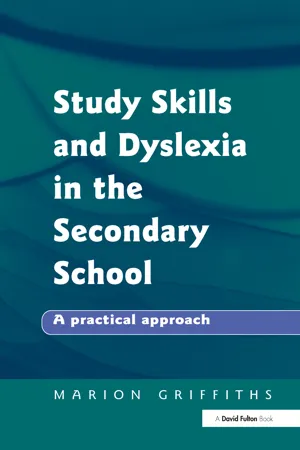![]()
Part 1
Assessment and secondary students with dyslexia
![]()
1 | Dyslexia and Assessment |
This chapter offers guidance to secondary personnel in approaching the initial assessment of students considered to be dyslexic. There is a brief history of dyslexia, and definitions of dyslexia are examined from a theoretical perspective. There is a checklist to determine visual, auditory and speech strengths and limitations of students. In addition there is a checklist for parents/guardians who can assist in assessing and supporting the student and a self-assessment worksheet for the student to complete. The legal requirements of the Revised Code of Practice (DfES 2002) and the American Individuals with Disabilities Education Act (IDEA 1997) are discussed. The chapter concludes with a list of suggestions for motivating secondary students’ learning.
Introduction
Formal and informal assessment approaches are integrated as part of the national educational system and teachers’ daily routine for raising standards in effective learning for all secondary students, including those with dyslexia. Standardised assessment tests can be administered to discover if students require special provision and to highlight students’ individual strengths and limitations. Through enlisting academic and non-academic support throughout students’ education it is envisaged that any perceived limitations will be short-lived. Theory has been used to underpin dyslexia and assessment. Central to this assessment process is the SENCO who must be kept fully informed at all times. The SENCO is a specialist teacher who takes an active role in ensuring that progress is made by students with special educational needs, including those with dyslexia. Among the many duties undertaken by the SENCO are advising school staff and parents and liaising with external experts.
Prior to assessing a student for dyslexia a secondary teacher should consider the answers to a checklist of questions. The objective of this checklist is to provide direction to the student assessment.
Checklist of Questions Teacher Should ask Prior to Student Assessment
- What is the purpose of assessment? What do you need to discover about the student that you do not already know?
- What resources are necessary for assessment?
- How and where is the assessment going to take place?
- Do students understand why they are being assessed?
- What is the best way to give feedback to students and how is it going to benefit them? What are the implications of the student assessment for the curriculum? Do students agree or disagree with their assessment?
- What is the appropriate format for circulating information from the student assessment to other interested parties?
- What actions do students need to take following assessment?
A Brief History of Dyslexia
In 1846 Pringle Morgan taught a 14-year-old boy named Percy who had difficulty spelling words with more than one syllable. He wrote his name as ‘Precy’. His teacher declared that ‘he would be the smartest lad in the school if the instruction were entirely oral’ (Morgan 1896). This identification has similarities with the former Code of Practice (DFE 1994) which claims that pupils may have good oral skills yet may experience difficulty with spelling. In 1861, Broca claimed that the inability to use language properly could be due to aphasia or damage to the brain (Miles and Miles 1990). Head (1926) echoed the same idea years later by suggesting that thoughts and speech could be affected by aphasia.
Kussmaul (1878) was the first person to identify ‘word blindness’ and ‘word deafness’. This theme was later developed in 1900 by James Hinshelwood, a Glaswegian eye surgeon, who explained his term of ‘congenital word blindness’ as:
a congenital defect occurring in children with otherwise normal and undamaged brains characterised by a difficulty in learning to read so great that it is manifestly due to a pathological condition, and where the attempt to teach the child by ordinary methods have completely failed.
(Hinshelwood 1917, p. 19)
Hinshelwood concluded that dyslexia could be hereditary and more frequent in boys than girls.
In 1937 Samuel Orton, an American neurologist considered that dyslexia was ‘strephosymbolia’ (twisting of symbols) rather than ‘word blindness’ when reading or spelling words. That is to say, words could be distorted. Studies on the subject of eye movements by Zangwill and Blakemore (1972) concluded that poor readers sometimes display erratic eye movements.
Dyslexia was first mentioned in the Chronically Sick and Disabled Persons Act in 1970, section 27 (DES 1970). Two years later this was followed by the Tizard Report (1972), which claimed that children with dyslexia had weaknesses with reading, writing, spelling and number. The emphasis of dyslexia was changed from reading to language difficulties in the Bullock Report (1975). From 1978 onwards it was recognised that children with special educational needs including those with dyslexia would require further consideration and special provision. The Warnock Report (1978), and the 1981 Education Act (DES 1981) gave children with dyslexia access to the main curriculum and it became feasible for a pupil with specific learning difficulties to have his or her special educational needs protected by the issuing of a ‘statement of special educational needs’ by the Local Educational Authority (LEA).
Definitions of Dyslexia and Assessment of Secondary Students
Differing definitions of dyslexia by acclaimed experts offer an insight to professionals to identify, assess and monitor pupils’ progress. Definitions of dyslexia provide a platform to compare and contrast with classroom practice. Frequently, dyslexia has been portrayed in literature as a ‘deficit model’ or as a negative condition. Current thinking has changed slightly to reflect a positive paradigm shift (West 1997). Students with dyslexia may have identified abilities which coexist alongside identified disabilities.
Schools in England and Wales currently need to be aware of the changes being made to the Revised Code of Practice which comes into effect in January 2002. Moving from the former Code’s (DFE 1994) precise definition of dyslexia the consultation document for t...
